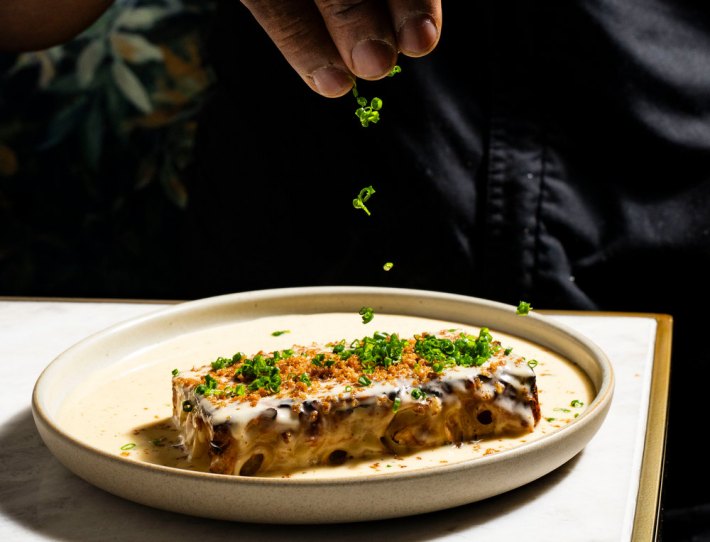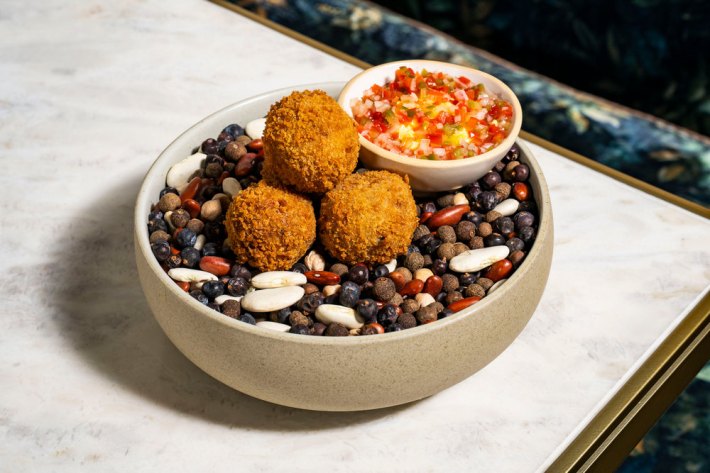Before moving to Los Angeles, chef Adrian Forte was living on the beach, working as a private chef, and “semi-retired,” as he tells L.A. TACO. Tomorrow he’s opening Lucia, an ambitious, upscale Caribbean restaurant on Fairfax Avenue, for which the chef moved to the West Coast to run.
“We don't really have a Per Se or, like, a French Laundry, or any restaurant like that where Black and brown chefs can go and learn how to cook this type of food high-level,” he says. “It wasn't about coming to Hollywood or getting the nice, warm weather, because I had nice, warm weather where I was. It was more so about creating an institution and having people come and learn how to cook this food and be able to go off and, you know, eventually do their own thing. For me, it's very purpose-driven.
Born in Kingston, Jamaica, Forte moved to New York as a teen before eventually settling in Ontario, Canada, where he worked at Cafe Boulud and was a semi-finalist on Top Chef Canada. His work has led him to serve as a private chef for stars like Drake, Alicia Keys, and Virgil Abloh.
He was tapped by owner-founder Sam Jordan, who traveled extensively around the Caribbean to inform his vision of a groundbreaking, market-driven, technique-centered restaurant extolling the flavors, traditions, and influences found across the region.
In anticipation of Lucia’s opening, we talked to Forte about five dishes he’s eager for people to try. What inspired them, and what goes into them? Warning, it will make you hungry.
Here are five dishes you’re going to want at Lucia.

Jerked Steak with Toum and Spiced Jus
“Most people don't know that ‘jerk’ is a method of cooking. For something to be considered jerk, you have to cook a protein, or anything for that matter, over pimento wood. So, we import pimento wood from Jamaica. It's about $45 a pound, and that's what we cook the steak over. It’s a jerk flat iron of wagyu that we get from Black Hawk Farms.
The pimento wood imparts that jerk flavor, and then we reinforce that pimento flavor with the jerk marinade. You've also got pimento in the dry spice mix and then you have pimento wood that is cooked over. So there's this reinforcement of that pimento flavor, and I think that's what makes it special, in that we're not cutting corners. We're not cooking it over, you know, just a traditional barbecue. We're not doing it on the flat top. We're not doing it on the charbroil. We're doing it over open flame. That lends to the flavor, with nice caramelization on the meat, and it's just a very beautiful steak. We make our jerk in-house, so it's not as spicy as a store-bought jerk because I can control the amount of heat on the scotch bonnet. It's very umami-forward and I find that it complements the steak well.”

Lychee Ceviche With Sorrel Leche, Avocado, and Rice Paper
“In the Caribbean, sorrel or hibiscus is usually a dish that we drink during the festive season, so during Christmas, during Easter, things of that nature. So, we really wanted to do something that was, you know, a celebration. We also wanted to have something for [our] vegan clientele. We say ceviche, but there's actually no fish in this dish. We just wanted to be innovative and be able to have people that have certain dietary restrictions or certain dietary preferences, be able to try something that's from the diaspora.
We marinate actual, fresh lychee, and then we make a traditional leche de tigre base. We combine that lychee base with the sorrel, the hibiscus drink, and that's the liquid that we use to serve the dish with. And that's just inspired by, you know, the tradition of making sorrel.”

Trini Mac Pie With Cheese Sauce and Brown Butter Bread Crumb
“This is like a very, very big thing in Trinidad. Trini Mac Pie is usually just a baked mac and cheese casserole, but traditionally, they use bucatini noodles, which I just found probably wouldn't sit well for an American-based audience. So, we went with a traditional Trini Mac Pie recipe, but we used some fancier cheeses, because in the Caribbean, they use, like, American processed cheese, which is so funny. So, I wanted to elevate that a bit.
We use Comte, we use Gruyere, we use Asiago. So, we went for the fancy cheeses, but everything was just traditional in that recipe, and served with a nice, warm cheese sauce on top. So, we make the mac and cheese, we bake it as a casserole, and then to order, we just reheat it in, like, little slivers or little bricks, and then we put, like, a nice core of that warm, fancy cheese sauce on top, brown butter, breadcrumbs, and some chives.”

Saltfish and Fig Croquettes
"This is our ode to St. Lucia, because the restaurant is named after the island, but, like, indirectly, not really. So we just wanted to do something for people from that region, because I know they're going to see the name, and they're going to make the connection, and they're going to be like, ‘hey, you know, this is us.’
Saint Lucia's national dish is saltfish and fig, which is salted cod with green bananas, which they call ‘figs’ in some Caribbean islands. They boil the bananas, and other ground provisions, like yams, stuff of that nature, water or salt, a little bit of aromatic, and they serve that with, like, cooked down salted codfish. And what happens is that they serve that with the codfish, avocados, and the codfish is cooked down in coconut milk, aromatics, and spices.
So, we just took the flavor of that dish, and we used the green banana as, like, our base for a croquette, and we just put everything into one bite-sized morsel. We cook down the salted cod with the coconut milk, with the aromatics, with the thyme, with the scotch bonnet, and then we get green bananas, we boil them, we mash them, and we use that as our base versus potatoes, and then we mix all that together. We put them into a little ball, we freeze them, panko crust them, and then fry them, and then it's served with a huancaina sauce. Our chef, Alex Fields, is very deep into Peruvian cuisine. He worked at a couple Peruvian restaurants before moving here to L.A. with me. So, he's very, very big on Peruvian, so he wanted to do a huancaina sauce as an ode to Peru, because we like to find interconnectedness with food. Then we put a salsa criolla on top, which is just like an Afro-Latin pico de gallo, essentially. So, that goes on top of the sauce, and it's served with the croquettes, and it's just like this nice, creamy, I don't even have the– it's making my mouth water talking about it.”

Oxtail Pepper Pot with Butter Beans, Farofa, and Fresno Pepper
“In Guyana, they make pepper pot during the Christmas season. Usually, they use different cuts of meat. For me, I grew up eating oxtail. Oxtail is prepared differently in many other regions, countries, and the West Indies. However, I particularly like the way Guyanese pepper pot is prepared, because they use what's called cassareep, which is a type of cassava molasses. I like the flavor of cassareep. I also like how it made their pepper pot look. Versus a Jamaican oxtail or versus, like, a Trinidadian oxtail. It was, like, nice and dark. So, we opted to do the Guyanese version.
This dish takes two days to make. We season up our oxtail with traditional oxtail spices, and then we smoke it over the pimento wood. There's no heat, but we smoke it over pimento wood to impart that pimento flavor. We smoke it and then we braise it in beef stock and, like, some nice warm spices and aromatics, and we use a little bit of cinnamon stick. All the flavors, you know, orange peel, all the flavors, the traditional flavors of a pepper pot. We braise the oxtail nice and slow at, like, 290 degrees for a whole day, right? So, after it gets smoked, it gets braised, and then we remove it from the braising liquid. We reduce that braising liquid, and then we add more stock, add red wine. We make what's called a demi. We take the stock, we cook it twice, cross the crunch technique, and then we get this, like, nice, thick, rich sauce from the braising liquid.
Then for service, we bring the oxtail back up to temperature, and we glaze it with that liquid, and we add more cassareep. So, it gets, like, nice and sticky and, like, super umami, but there's also, like, a little bit of bitterness, because cassareep comes from the cassava plant. It's the starch that gets reduced from cassava. So, it has a little bit of a bitterness to it.
I like spicy. I like salty. I like bitter. I like sour. I like playing off of all those flavors. So, when you bite into that, you get a little bit of bitterness from the cassareep, but you get a little bit of sweetness also, because it's a reduction, and then you get, like, a nice, unctuous, umami flavor, because, you know, we, like I said, we cook it down in the beef stock, and then we reduce that, fortifying the flavor of the cassareep. Then what we do is we finish that dish by piping on some white bean puree. In traditional Jamaican oxtail, we would always serve it with lima beans in the stew. So, I wanted to incorporate that element in a different aspect.
So, we just, we take some lima beans, we cook them down in coconut milk, we whip them, we pipe them over the oxtail, and then we do, um, pickled and grilled Fresno peppers as a garnish. And then, to really finish off the dish, um, we sprinkle some Brazilian farofa, which is just, like, a cassava crumble. We just basically toss that with some butter, we season it up, sprinkle it on top of the oxtail, and it's kind of, it adds a crunch, um, a crunchy texture to the dish, so it's a textural element, but it's kind of like a savory graham cracker, but it's gluten-free because it is cassava, right? That adds a textural component to the dish.
When you bite into that, you get, like, you know, sticky, gooey, umami-forward, sweet from the glaze, or the reduction, the meat falling off the bone, you get that creaminess from the whipped lima beans, and then you get a crunch from the farofa, and then you get, like, a nice bite of acidity from the pickled Fresno that we also char to give it a smoky flavor. So, all together, it's a very, very well-balanced dish. One of my favorite things that I make.”
Lucia ~ 351 N. Fairfax Ave. Los Angeles, CA 90036








